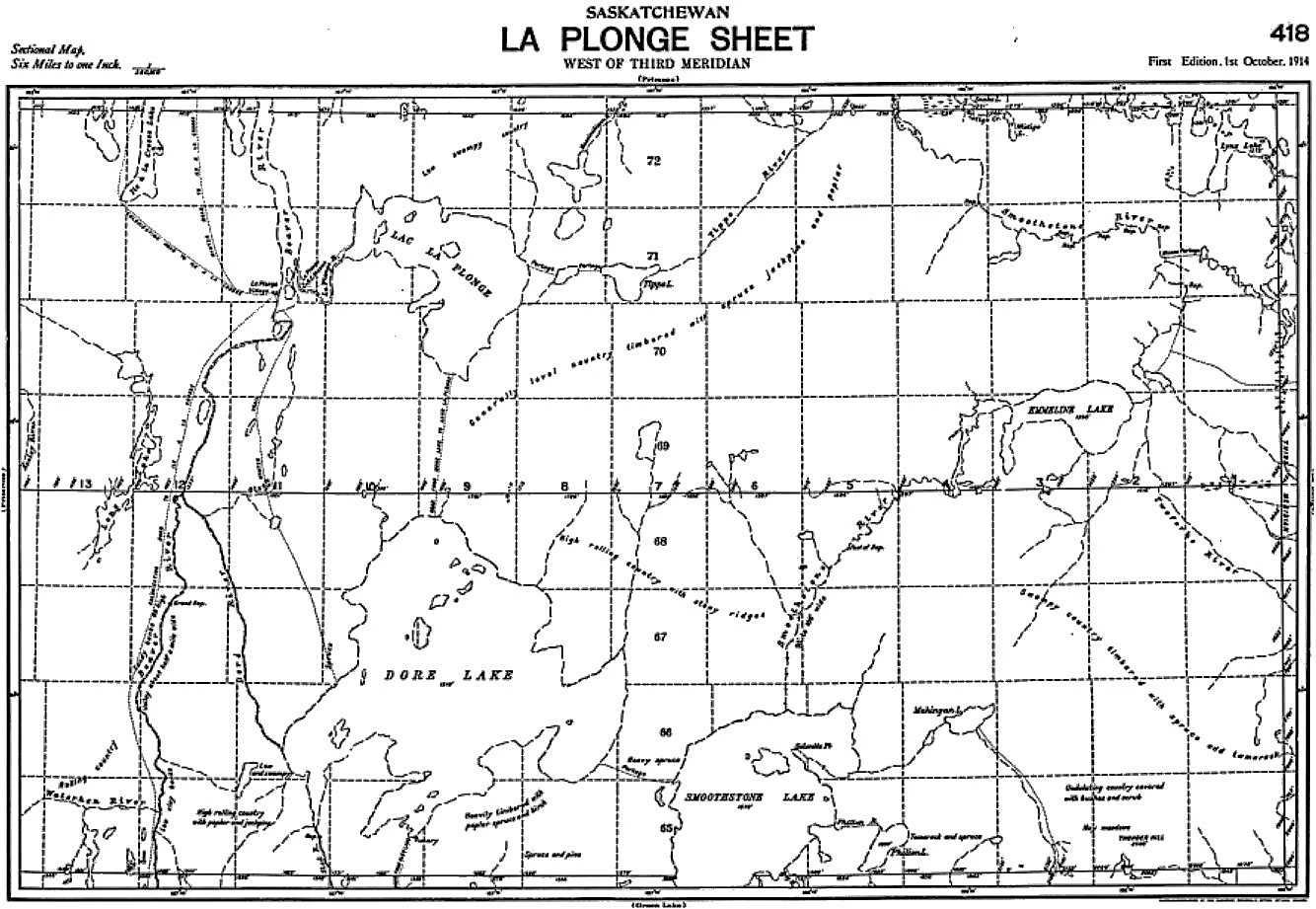
|
Dore Lake is a small settlement of fifty-five people or so on the south bay of Dore Lake, Saskatchewan. The name is derived from the French word "d'or," which means gilt or golden. It was chosen by the early settlers because of the golden reflection of fish as they cleared the water in the evening sun. The Lake itself is large - covering an area of approximately 550 square miles. 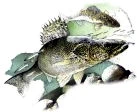
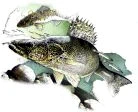
They, the men and women who chose to eke out a living in the Northern Saskatchewan bush came from Scandinavia, Iceland, Eastern Europe, the United States and southern Saskatchewan. Farm labourers, new Canadians, and transient workers came north seeking winter employment in the occupations - logging, trapping, freighting and fishing - that the environment offered. Many hoped to gain a few extra dollars, and others to experience the challenge of another life style. Each person's first experiences in the unknown northland combines to form a unique adventure. When men and women first canoed the waterways to Dore Lake, they witnessed beautiful wilderness and disturbing thoughts of isolation. When they first trekked fifty-five miles along the frozen muskeg and lakes, between Big River and Dore Lake, they learned to respect and fear the winter. Nature's elements may have been distressing and disagreeable at times, but the men and women were a courageous lot that adapted wholeheartedly. The women folk learned to bake on tin stoves, dress fish, construct fish boxes, and cope with a loneliness that isolation brings. The men grew accustomed to the long hours spent working outside in temperatures of forty and fifty below. In the early spring, they made long journeys on foot to civilization. Here, they were reacquainted with another type of existence. They returned to their summer jobs as farm labourers, mill workers, or factory workers in the south. While enjoying the summer heat and comforts of city life, they swore they would never return to that life of baking soda biscuits, boiled fish, fishy mitts and bitter cold. They vowed they'd never again attempt to travel by horse team on thin ice or walk through half-frozen muskegs. But they returned. Every fall an inexplicable urge drove them north again. Here is their story. The experiences of the men and women, who through hardships, sharing and determination, created a community with a very unique history. The first government survey of Dore Lake was conducted in 1914. The survey report gives a good description of the Dore Lake environment and what the surveyors encountered on their first trip to the area: "I beg to submit the following report accompanied by a map and scale of three miles to one inch, upon an area examined by Saskatchewan Reconnaissance Survey Party No. 2, during the past summer. "In accordance with your instruction I reported to the District Inspector at Prince Albert on May 17th. There I received my outfit and supplies, and proceeded by train to Big River, where I hired a cook. "Mr. Hughson, my assistant, joined me in Big River and as the District Inspector had instructed me to examine the northern part of the area first, we left on May 25th for Dore Lake (via Crooked Lake, Crooked River, Beaver River and Dore River)." "Our outfit consisted of an eighteen foot Chestnut freight canoe, a ten by twelve silk tent with a mosquito tent, a cooking outfit and other necessary camp paraphernalia. "My assistant and I worked separately except during the early part of the season, and in this connection I wish to say that Mr. Hughson was most willing and efficient and rendered valuable assistance. Our method of work was to run reconnaissance lines inland from the lakes and rivers at intervals of about three miles, moving camp every two or three days. "The temperature during the day time in the summer is, as a rule, not extreme -- the average maximum being probably between 70 and 75 degrees. On a few days however, I am sure at least 95 degrees must have been registered. The nights are almost invariably, quite pleasantly cool. The last spring frost occurred about May 31st and the last killing frost in the fall, on September 3rd. "The winters are extremely cold; temperatures of 70 degrees below zero is occasionally reached and protracted periods of a week or ten days, when the maximum is 40 degrees below zero, are not unusual. "From what I could learn in conversation with trappers and Indians, the past summer was exceptionally dry, but the rainfall is never very great. The total snow fall seldom exceeds three feet. "I should judge that, climatically the area is suited for agriculture, but the uncertainty in regard to frost would tend to make it somewhat precarious. "The area in general, is a broken plane characterized by heavy accumulation of drift, which for prominent hills, especially noticeable on Dore and Smoothstone Lakes. "White spruce is the commercial tree of the area. It is not found in pure stands, but always in a mixture, chiefly of poplar, under which it reproduces heavily. It reaches its best development on well drained soils. The largest individual was noted on a high hill on the south shore of Dore Lake. "In the spruce-aspen areas, where dense, the herbaceous growth consists of violets, strawberry, sarsaparilla, and other plants whose names were not known. In more open woods, peavine grows thickly with a profusion of golden-rod and wild orange lilies. The underbrush consists of hazel, cranberry, gooseberry, and other small shrubs. "In jackpine, the floor cover consists chiefly of caribou moss, blueberry, and a plant (kinikinick) which the Indians dry and mix with their tobacco. "Moose are very plentiful, and trappers and Indians shoot them regardless of the season. However, if the game laws were enforced a hardship would be inflicted especially on the Indians, as these people depend chiefly upon fresh meat and fish for food, and the number of moose is so great that there is little danger of their being materially decreased, at present rate of killing. "I was informed that occasional jumping deer are found and that, in the winter, many woodland caribou range as far south as the muskeg between Dore Lake and River - a district known locally as the "wilderness". "Several coyotes and lynx were seen. Wolves run in large packs on Dore and Smoothstone Lake districts in the winter. "Ducks, chiefly mallard, black, fall and teal are present in thousands. Every slough and lake in the area is used by them as a breeding place. Waterhens, and pelicans are also plentiful. There are three boulder islands in Dore Lake, which are thickly covered with gulls and crow ducks in the breeding season. "Partridge and spruce chickens are quite plentiful." 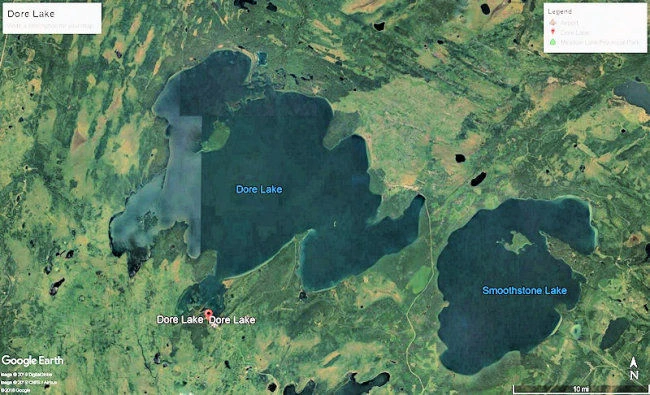
Map of the Dore Lake area. 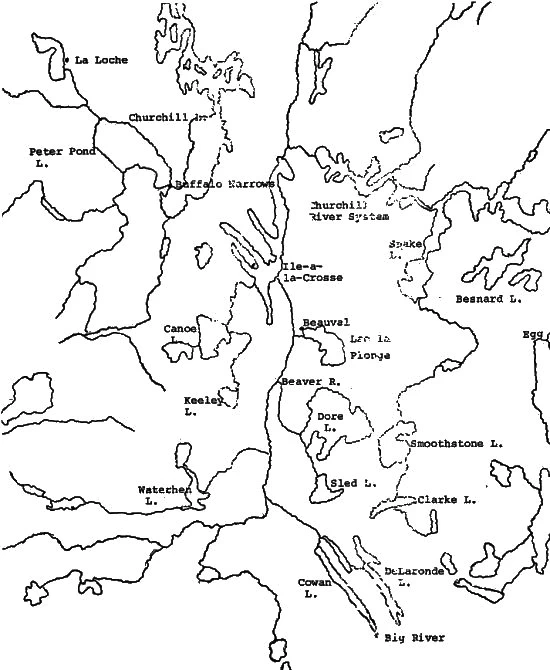
Map of the Dore Lake area.
For a larger view of the Dore Lake map,
click on the picture. |
| Deep River Fur Farm |
| Deep River Trapping Page |
| Deep River Fishing Page |
| My Norwegian Roots |
| Early Mink People Canada - Bowness |
| The Manager's Tale - Hugh Ross |
| Sakitawak Bi-Centennial - 200 Yrs. |
| Lost Land of the Caribou - Ed Theriau |
| The History of Buffalo Narrows |
| Hugh (Lefty) McLeod, Bush Pilot |
| George Greening, Bush Pilot |
| Timber Trails - History of Big River |
| Joe Anstett, Trapper |
| Bill Windrum, Bush Pilot |
| Face the North Wind - Art Karas |
| North to Cree Lake - Art Karas |
| Look at the Past - History Dore Lake |
| George Abbott Family History |
| These Are The Prairies |
| William A. A. Jay, Trapper |
| John Hedlund, Trapper |
| Deep River Photo Gallery |
| Cyril Mahoney, Trapper |
| Saskatchewan Pictorial History |
| Who's Who in furs - 1956 |
| Century in the Making - Big River |
| Wings Beyond Road's End |
| The Northern Trapper, 1923 |
| My Various Links Page |
| Ron Clancy, Author |
| Roman Catholic Church - 1849 |
| Frontier Characters - Ron Clancy |
| Northern Trader - Ron Clancy |
| Various Deep River Videos |
| How the Indians Used the Birch |
| The Death of Albert Johnson |
| Mink and Fish - Buffalo Narrows |
| Gold and Other Stories - Richards |
